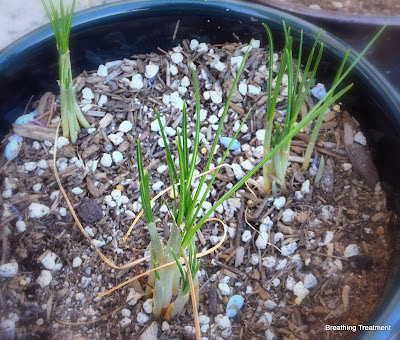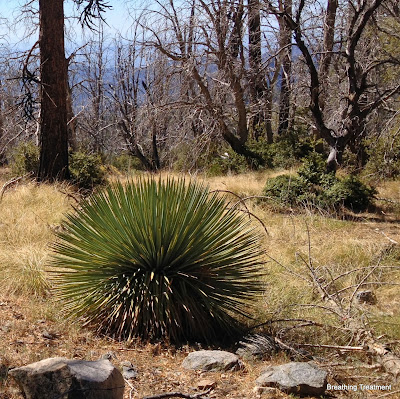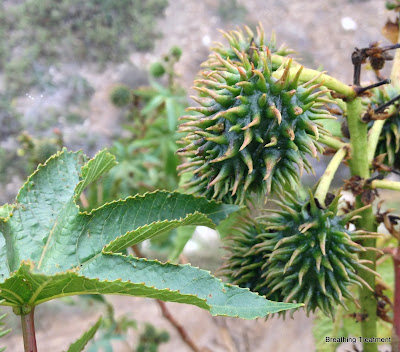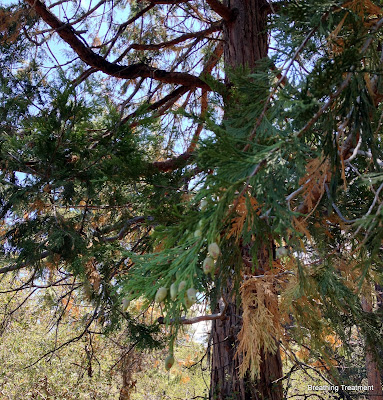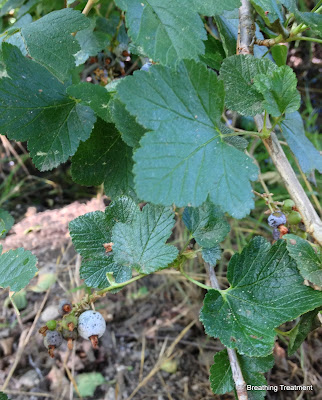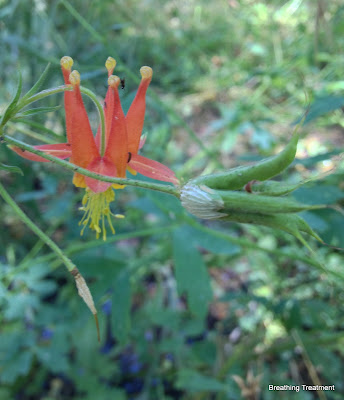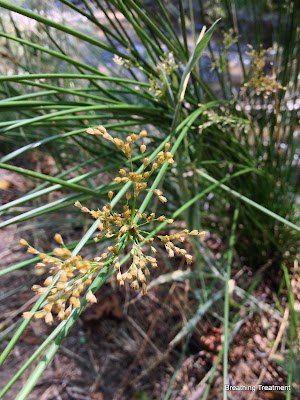2013-12-20
Sunset with Lemonade Berry
2013-12-10
October to November garden
Back on October 7, my bulbs started greening up. First the Crocus sativus (Saffron Crocus)
By November 22, the C. sativus had grown a bit:
Native bulbs were showing some life too by Nov 22. Don't ask me just now which one this is.
On Oct 7 the unknown exotic was just showing:
I planted this Sedum 'Harvest Moon' just before Thanksgiving and took these pictures on 12/9. It's fragile and I placed the broken bits in other nearby pots where it looks like they will take. I may be overwhelmed with it by next year.
I think these are Datura wrightii (Loco weed, sacred Datura) seedlings. At least, that 's what I scattered in this container just before Thanksgiving. The picture was taken on 12/9. A companion container planted at the same time isn't showing any growth, however, so these may be adventitious sprouts.
I think this is Dichelostemma capitatum (Blue Dicks), a bulb native to western N. America.
Manzanita flowers are beautiful and delicate. It looks like a ruthless pollinator has gotten into this one from the side. That happens.
Finally, I found these fun mushrooms the other day and chose them to make a "family" portrait on 12/9. We'll see how fast they grow ;-)
By November 22, the C. sativus had grown a bit:
Native bulbs were showing some life too by Nov 22. Don't ask me just now which one this is.
On Oct 7 the unknown exotic was just showing:
I planted this Sedum 'Harvest Moon' just before Thanksgiving and took these pictures on 12/9. It's fragile and I placed the broken bits in other nearby pots where it looks like they will take. I may be overwhelmed with it by next year.
I think these are Datura wrightii (Loco weed, sacred Datura) seedlings. At least, that 's what I scattered in this container just before Thanksgiving. The picture was taken on 12/9. A companion container planted at the same time isn't showing any growth, however, so these may be adventitious sprouts.
I think this is Dichelostemma capitatum (Blue Dicks), a bulb native to western N. America.
Manzanita flowers are beautiful and delicate. It looks like a ruthless pollinator has gotten into this one from the side. That happens.
Finally, I found these fun mushrooms the other day and chose them to make a "family" portrait on 12/9. We'll see how fast they grow ;-)
2013-12-09
Rain 0.27"; season total 1.36"
In the last two years we've had over 2" cumulative rainfall by early December at my current address. As of today, we have 1.36" total in my back yard. However, don't lose heart for a wet winter: California often has highly variable rainfall and neither of the figures I just mentioned is out of bed for a typical (50% of the time) water year. Based on 1944 to 2010 rainfall records, the median rainfall for Los Angeles changes from 1.06" to 2.30" from the end of November to the end of December. So far we're typical.
29-Nov 0.40" - This could have been greater. I checked it a day or two after the storm went through so evaporation could have reduced it.
7-Dec 0.27"
Total: 1.36" (or a bit larger since I dilly dallied in making a record of the 0.40" rainfall)
29-Nov 0.40" - This could have been greater. I checked it a day or two after the storm went through so evaporation could have reduced it.
7-Dec 0.27"
Total: 1.36" (or a bit larger since I dilly dallied in making a record of the 0.40" rainfall)
2013-12-08
2013-11-21
Rain 0.54"; season total 0.69"
We had a late October start to our rainy season this year and then nothing much (some trace amounts that I don't record) until last night when we had a steady light rain that dropped over 0.5 inch. This is just the sort of rainfall that gardeners like - the kind that soaks in.
The 27 Oct date for the start of our measurable rainfall is the latest that I've measured since I started keeping track in 2004. However, median LA rainfall in November is just under 1" (0.93") and we are not out of bed with that guideline, yet, particularly with rain still in the forecast.
Date Amount Total
27-Oct 0.15" 0.15"
20-Nov 0.54" 0.69"
The 27 Oct date for the start of our measurable rainfall is the latest that I've measured since I started keeping track in 2004. However, median LA rainfall in November is just under 1" (0.93") and we are not out of bed with that guideline, yet, particularly with rain still in the forecast.
Date Amount Total
27-Oct 0.15" 0.15"
20-Nov 0.54" 0.69"
2013-10-22
Euphorbia terracina
Here's a weed that's easy to pull and one where you might feel that an investment of time now will have a real preventive impact. The weed is Euphorbia terracina (Geraldton carnation weed, false caper), and it's just getting established nearby. Early prevention could make a difference, so exterminate on sight.
2013-10-21
Jubata or Pampas?
I started reading about Pampas grass (Cortaderia selloana), and then quickly decided that I really ought to be reading about Jubata grass (Cortaderia jubata). Both are undesirable invasive weeds along the California coast, but Jubata grass is more widespread.
According to Cal-IPC one way to discriminate is by pannicle (flower) height.
Jubata grass (Cortadaria jubata) is a perennial grass six to twenty-three feet tall with long leaves arising from a tufted base or tussock. The inflorescence or flower cluster is a plumed panicle at the end of a long stem. Stems generally are at least twice as long as the tussock. Plumes consist of hairy female flowers, deep violet when immature, turning pinkish or tawny cream-white at maturity. Jubata grass is easily confused with, and often called, pampas grass (Cortaderia selloana). The two species are distinguished by stem height, leaf, plume, and spikelet color, florets, leaf tip, and presence of viable seed. The tussocks of jubata grass are less erect and more spreading and not fountain-like, when compared to tussocks of Cortaderia selloana.
According to Cal-IPC one way to discriminate is by pannicle (flower) height.
Jubata grass (Cortadaria jubata) is a perennial grass six to twenty-three feet tall with long leaves arising from a tufted base or tussock. The inflorescence or flower cluster is a plumed panicle at the end of a long stem. Stems generally are at least twice as long as the tussock. Plumes consist of hairy female flowers, deep violet when immature, turning pinkish or tawny cream-white at maturity. Jubata grass is easily confused with, and often called, pampas grass (Cortaderia selloana). The two species are distinguished by stem height, leaf, plume, and spikelet color, florets, leaf tip, and presence of viable seed. The tussocks of jubata grass are less erect and more spreading and not fountain-like, when compared to tussocks of Cortaderia selloana.
2013-10-18
Planting the fall garden
Fall is like New Years for California native gardeners - always the promise of literally turning over a new leaf.
I mentioned just the other day about how I shopped online at Annie's Annuals for some fall plantings, but additional guilty pleasures of local plant sales weren't far away and offered other tantalizing new plants as well as old favorites to augment what's working.
I couldn't stay away from the SCCNPS plant sale where my tastes ran to really local plants and then less than a week later I made a trip to the Rancho Santa Ana Botanic Garden nursery, Grow Native, in Westwood. I did manage to exert enough self-control to avoid the Payne Foundation's plant sale this year. Nonetheless, all told I had about 20 new plants. My prior tendency has been to get them in the ground a bit at a time, but this year I did them all in one fell swoop.
How did I manage to prep and plant that many new plants? The magic of government furloughs came into play giving me ample time to enjoy a curious mental state half way between unemployment and retirement. I guess there's at least one thing for which I can thank the radical edge of the Republican party.
I've decided to keep track of what I've planted using the simplest method possible: I just take a photo of the installed plant next to its empty container. Not the most aesthetic, but definitely the easiest way for me to maintain my records. This is a long post, so click to read more at your peril.
I mentioned just the other day about how I shopped online at Annie's Annuals for some fall plantings, but additional guilty pleasures of local plant sales weren't far away and offered other tantalizing new plants as well as old favorites to augment what's working.
I couldn't stay away from the SCCNPS plant sale where my tastes ran to really local plants and then less than a week later I made a trip to the Rancho Santa Ana Botanic Garden nursery, Grow Native, in Westwood. I did manage to exert enough self-control to avoid the Payne Foundation's plant sale this year. Nonetheless, all told I had about 20 new plants. My prior tendency has been to get them in the ground a bit at a time, but this year I did them all in one fell swoop.
How did I manage to prep and plant that many new plants? The magic of government furloughs came into play giving me ample time to enjoy a curious mental state half way between unemployment and retirement. I guess there's at least one thing for which I can thank the radical edge of the Republican party.
I've decided to keep track of what I've planted using the simplest method possible: I just take a photo of the installed plant next to its empty container. Not the most aesthetic, but definitely the easiest way for me to maintain my records. This is a long post, so click to read more at your peril.
2013-10-17
Fall growth and renewal in the garden
You know it's fall when the bulbs start to poke their head above ground. Here I have an unknown exotic (bottom) that I enjoyed immensely last year and a few sprouts of Crocus sativus (saffron crocus - top) of which I have many pots. Perhaps this year they will bloom and I can give them as Easter gifts.
Of course, one sign of fall is ripping the Agapanthus (Lily of the Nile) out to make room for more interesting and important plants....
Of course, one sign of fall is ripping the Agapanthus (Lily of the Nile) out to make room for more interesting and important plants....
Order from Annie's
My recent order from Annie's Annuals and inner thoughts:
1 Cirsium occidentale "Cobweb Thistle" 3 $8.95 $26.85 (loved these last year but not certain they have self sown)
2 Clematis ligusticifolia "Western White Clematis" 2 $7.95 $15.90 (A purposeful purchase for the fence in front)
3 Dudleya traskiae "Santa Barbara Liveforever" 2 $8.95 $17.90 (Couldn't resist a channel island plant since I live on a former channel island)
4 Gilia tricolor "Birds Eyes" 1 $4.95 $4.95 (why not, shipping is the same whether ordering 7 or 8)
Subtotal $65.60 (YIPES!)
Discount (25% off) -$16.40 (Whew!)
Sales Tax (7.5%) $3.69 (Damn Revenuers!)
Shipping $13.95 (Less than the cost of making the drive, I guess)
Gift Card Card $10.00 (ahhhh)
Total $56.84 (Grrr, but muted somewhat.)
It appear that there was some unexpected handling issues and the Dudleya plants got loose (open slots in photo), acting like large and heavy bulls in the china shop, crushing and breaking everything they tumbled into. Near disaster was averted, however: I immediately got all these planted and the crushed plants seem to have recovered quite well. Had I needed to call Annie's I'm sure they would have treated me well, since they have in the past.
1 Cirsium occidentale "Cobweb Thistle" 3 $8.95 $26.85 (loved these last year but not certain they have self sown)
2 Clematis ligusticifolia "Western White Clematis" 2 $7.95 $15.90 (A purposeful purchase for the fence in front)
3 Dudleya traskiae "Santa Barbara Liveforever" 2 $8.95 $17.90 (Couldn't resist a channel island plant since I live on a former channel island)
4 Gilia tricolor "Birds Eyes" 1 $4.95 $4.95 (why not, shipping is the same whether ordering 7 or 8)
Subtotal $65.60 (YIPES!)
Discount (25% off) -$16.40 (Whew!)
Sales Tax (7.5%) $3.69 (Damn Revenuers!)
Shipping $13.95 (Less than the cost of making the drive, I guess)
Gift Card Card $10.00 (ahhhh)
Total $56.84 (Grrr, but muted somewhat.)
It appear that there was some unexpected handling issues and the Dudleya plants got loose (open slots in photo), acting like large and heavy bulls in the china shop, crushing and breaking everything they tumbled into. Near disaster was averted, however: I immediately got all these planted and the crushed plants seem to have recovered quite well. Had I needed to call Annie's I'm sure they would have treated me well, since they have in the past.
2013-10-16
Flora of Lair of the Bear 6-16-13
I took these pictures last summer during a family vacation near Pinecrest. Pinecrest Lake is shown below.
I took a simplistic approach to identifying them with the help of CalFlora.org and my own intuition, so the IDs could be wrong.
I took a simplistic approach to identifying them with the help of CalFlora.org and my own intuition, so the IDs could be wrong.
2013-10-05
Fall means plant sales!
The local chapter of the California Native Plant Society (SCCNPS) had their native plant sale the other day and of course I was there. Some of the plants have already made it into my garden. The SCCNPS sale features and identifies many locally native plants, many of which are propagated from local seed or cuttings. This year I found myself gravitating strongly to the locals.
This Red Buckwheat (Eriogonum grande rubescens) joined two others that I planted in the last year. Three is a magic number that has many visual aesthetics and one of the earlier plantings had died, a victim of animal activity in my garden, so I had to replace it.
Of the two existing in my garden before this new one was installed, one was planted somewhat earlier in the winter than the other and the earlier one is by far the larger and more robust. This just goes to illustrate that fall to winter is the best planting time for many of these native plants - they sink deeper roots that allow more top growth if they get just a few more weeks / months in the ground with cool temperatures and moist soil.
This Red Buckwheat (Eriogonum grande rubescens) joined two others that I planted in the last year. Three is a magic number that has many visual aesthetics and one of the earlier plantings had died, a victim of animal activity in my garden, so I had to replace it.
Of the two existing in my garden before this new one was installed, one was planted somewhat earlier in the winter than the other and the earlier one is by far the larger and more robust. This just goes to illustrate that fall to winter is the best planting time for many of these native plants - they sink deeper roots that allow more top growth if they get just a few more weeks / months in the ground with cool temperatures and moist soil.
2013-10-04
Curious small piles of dirt
The other day I noticed some curious small piles of dirt in Juli's garden among the Fragaria (Strawberry) plants. In the picture below, little earthen piles are located midway between top and bottom at left and right sides of the photo. I thought they were earthworm castings at first.
It turns out that there was a small flying creature (yellow, perhaps a wasp) that inhabited them. Here it is, a bit out of focus due to my cell phone camera's autofocus "feature".
It turns out that there was a small flying creature (yellow, perhaps a wasp) that inhabited them. Here it is, a bit out of focus due to my cell phone camera's autofocus "feature".
2013-10-03
Early fall in the San Gabriel Mountains
It's my favorite time of year - fall. Fall in the southern California mountains has some nice surprises in it - even those plants that have gone to sleep to endure the summer still often have something to offer. A case in point is the Crystal Lake to Mt Islip trail, which I've hiked a couple times in the past year. It's a good hike, rising from around 5,000' to about 8,000'. The Curve Fire in 2002 wiped out many of the established conifers, but there has been some regeneration of the understory plants.
I think this is Hesperoyucca whipplei (chaparral yucca). This used to just be called yucca, but there was a recent renaming. Don't let anyone tell you that the Latin names never change, because they do.
More below. As always, I welcome corrections on my plant IDs.
More below. As always, I welcome corrections on my plant IDs.
2013-10-02
2013-10-01
2013-09-30
2013-09-29
2013-09-28
2013-09-27
Kings Canyon 6-24-13
We hit the trail early the next day. The young men I traveled with were 15, 16, and 15 years old (left to right below). This was their first long term backpack trip.
Most of the shots I will post here will not be people pictures. Click on to the rest of the blog post to see the interesting wildlife and plants that I saw. I may or may not get around to ID'ing the plants in this blog post.
Most of the shots I will post here will not be people pictures. Click on to the rest of the blog post to see the interesting wildlife and plants that I saw. I may or may not get around to ID'ing the plants in this blog post.
2013-09-23
Lunada Canyon gardening
I volunteer about once per month to look after Lunada Canyon. This weekend I was inspired to spend about an hour cutting back on some Acacia cyclops (aka red-eyed wattle or coastal wattle) which is a native of Australia that is invasive in California due to prolific seed production and bird-dispersal of seeds.
In South Africa, they have used biological pest control to decrease the spread of this plant. They report 90-100% seed damage when a seed-feeding weevil, Melanterius servulus, was unleashed on the Acacia population.(Biological control of an alien tree, Acacia cyclops, in South Africa: impact and dispersal of a seed-feeding weevil, Melanterius servulus, F.A.C. Impsona, V.C. Morana, J.H. Hoffmanna). (The bad news is that the weevil spreads about 2 km per year.)
As I started cutting back Acacia branches, I found Artemisia Californica (California sagebrush) and Heteromeles arbutifolia (Toyon) hidden under the outer branches. Photo above shows Toyon in foreground and Acacia in background.
In South Africa, they have used biological pest control to decrease the spread of this plant. They report 90-100% seed damage when a seed-feeding weevil, Melanterius servulus, was unleashed on the Acacia population.(Biological control of an alien tree, Acacia cyclops, in South Africa: impact and dispersal of a seed-feeding weevil, Melanterius servulus, F.A.C. Impsona, V.C. Morana, J.H. Hoffmanna). (The bad news is that the weevil spreads about 2 km per year.)
As I started cutting back Acacia branches, I found Artemisia Californica (California sagebrush) and Heteromeles arbutifolia (Toyon) hidden under the outer branches. Photo above shows Toyon in foreground and Acacia in background.
2013-09-16
Site redesign
Bear with me while I play: I'm changing the look of my blog.
Update 9/20: After playing with some options, I've given the look and feel of the blog just a light overhaul. Google+ is now integrated and some of the graphics are changed. I've also decided that I'll focus this blog a bit more sharply on California native plants, the outdoors, and gardening which is where my recent activities and posts have been focused anyway.
The template that I'm using seems to want to force me to have a turquoise colored font for blog post titles. If I could change that, I'd feel like I was done. (Changed! I needed to change the "link" color. I spent a long time looking in vain for a title color.) I might have to edit the HTML which has become a whole lot more sophisticated than when I was building web sites a decade ago.
I'm nearing my 1000th blog post, which isn't remarkable, but it is a milestone. This post is number 941, I believe.
As always, the blog will stay advertisement-free. I have borrowed an ad-free graphic (Town Mouse and Country Mouse have used it for years) to emphasize that fact.
Update 9/20: After playing with some options, I've given the look and feel of the blog just a light overhaul. Google+ is now integrated and some of the graphics are changed. I've also decided that I'll focus this blog a bit more sharply on California native plants, the outdoors, and gardening which is where my recent activities and posts have been focused anyway.
The template that I'm using seems to want to force me to have a turquoise colored font for blog post titles. If I could change that, I'd feel like I was done. (Changed! I needed to change the "link" color. I spent a long time looking in vain for a title color.) I might have to edit the HTML which has become a whole lot more sophisticated than when I was building web sites a decade ago.
I'm nearing my 1000th blog post, which isn't remarkable, but it is a milestone. This post is number 941, I believe.
As always, the blog will stay advertisement-free. I have borrowed an ad-free graphic (Town Mouse and Country Mouse have used it for years) to emphasize that fact.
By using this icon on my website I am stating...
1. That I am opposed to the use of corporate advertising on blogs.
2. That I feel the use of corporate advertising on blogs devalues the medium.
3. That I do not accept money in return for advertising space on my blog.
signed,
Brent
2013-08-27
Gophers like castor roots
I volunteer in a local canyon that is owned by a land conservancy. My charter is to survey invasive plants and I do so about once per month, hiking around and doing a little bit of wild gardening to encourage recovery of the local native plants. I wish I had more time to spend there, so I'm always looking for ways to multiply my efforts. I may have found an unwitting ally. Here's how:
Last month I noted in my report the the land conservancy that the castor beans (castor plant or Ricinus communis, a plant from eastern Africa that is considered invasive) were going to seed that that the small to medium sized plants were easy enough to pull from the loose, sandy, soil.
This month I returned to see that the conservancy had been working in the canyon while I was gone and had done extensive cutting of many invasive plants - mostly anise (Foeniculum), which had immature seeds. (By doing this work they were preventing the seeds from spreading further.)
I also noted that majority of the young castor bean plants were now dead.
I thought the conservancy had sprayed them with an herbicide. Not so.
Last month I noted in my report the the land conservancy that the castor beans (castor plant or Ricinus communis, a plant from eastern Africa that is considered invasive) were going to seed that that the small to medium sized plants were easy enough to pull from the loose, sandy, soil.
This month I returned to see that the conservancy had been working in the canyon while I was gone and had done extensive cutting of many invasive plants - mostly anise (Foeniculum), which had immature seeds. (By doing this work they were preventing the seeds from spreading further.)
I also noted that majority of the young castor bean plants were now dead.
I thought the conservancy had sprayed them with an herbicide. Not so.
2013-08-26
Weed barrier disaster
One of my neighbors thinks that essential garden elements include weed barrier cloth. They have thought this for years, since there's been no status change to this street side parking strip for at least that long. Don't do this.


- Posted from my iPhone


- Posted from my iPhone
2013-08-21
Flora of the Santa Ana River Trail - herbaceous plants
Most people know this as the Santa Ana River Trail (2E03). The sign maker apparently did not.
I've really only made educated guesses about the plant IDs, so I'd welcome disagreement; sharp-eyed readers should feel free to leave their corrections. As noted in an earlier blog post, I need to step up my photography for definitive plant ID. I'm kicking this out of draft mode because I've lost the drive to drill down on plant species for the moment.
I've really only made educated guesses about the plant IDs, so I'd welcome disagreement; sharp-eyed readers should feel free to leave their corrections. As noted in an earlier blog post, I need to step up my photography for definitive plant ID. I'm kicking this out of draft mode because I've lost the drive to drill down on plant species for the moment.
2013-08-14
2013-08-10
Beach access in Florida
This is what public beach access and dune preservation along Florida's Spacecoast look like.



The trees at right are Mangroves. The grass is oat grass.

- Posted from my iPhone



The trees at right are Mangroves. The grass is oat grass.

- Posted from my iPhone
2013-08-09
Sea oats


Floridians seem to have an awareness that their coastline is best preserved by native plants. Mangrove forests abound too.
- Posted from my iPhone
2013-08-08
2013-08-07
Flora of the Santa Ana River Trail - Calocedrus and Quercus
I've come to the conclusion that I really need to step up my photography in order to make better species ID. Too many times the ID is dependent on small features such as finding hairs on the undersides of leaves, or something equally obscure.
Hiking along the Santa Ana (or Anna) River Trail, I came across this Incense Cedar (Calocedrus decurrens) and a number of its progeny growing nearby. This is an uncommon tree at Camp Tahquitz, so I spent some time admiring it assuming it to be a singular example. Not so. Just around the corner was a dense stand of them. The smell was delightful!
More after the break
Hiking along the Santa Ana (or Anna) River Trail, I came across this Incense Cedar (Calocedrus decurrens) and a number of its progeny growing nearby. This is an uncommon tree at Camp Tahquitz, so I spent some time admiring it assuming it to be a singular example. Not so. Just around the corner was a dense stand of them. The smell was delightful!
More after the break
2013-08-05
Flora of the Santa Ana River corridor
Found in the riparian corridor along a very short stretch of the Santa Ana river in Barton Flats.
Rosa (perhaps R. californica or, more likely, R. woodsii ssp. ultramontana):
I'm certain this is Ribes nevadense (Sierra currant, mountain pink currant):
Aquilegia formosa (Columbine, Crimson Columbine, Sitka columbine, western columbine):
Perhaps a Juncus? Maybe even J. effusus (Bog Rush, common bog rush, common rush).
Rosa (perhaps R. californica or, more likely, R. woodsii ssp. ultramontana):
I'm certain this is Ribes nevadense (Sierra currant, mountain pink currant):
Aquilegia formosa (Columbine, Crimson Columbine, Sitka columbine, western columbine):
Perhaps a Juncus? Maybe even J. effusus (Bog Rush, common bog rush, common rush).
2013-08-04
Flora of Camp Tahquitz - Ribes, Quercus, Sambucus, and Solidago
I was back at Camp Tahquitz recently and took a few more plant photos, which I've identified to the best of my ability. As always, if you have a different opinion, I'd like to hear from you.
Ribes cereum (wax currant). This is one of three types of Ribes (goosberries and currants) that exist around camp.
A nearby oak is identified by sign as Canyon Live Oak (Quercus chrysolepis, Canyon Oak, Maul Oak, Goldcup Oak, Gold cup Live Oak, canyon live oak, gold cup oak). Q. chrysolepsis exist nearby, but from what I can tell they have a much smoother edge to their leaf.
So while I think it's definitely an oak (Quercus), I think it's a different species of oak. Candidates that are locally known and reported on Calflora are Quercus dumosa (Nuttall's scrub oak, coastal sage scrub oak, scrub oak) and Quercus wislizeni var. frutescens (Chapparal Oak, Live oak, bush interior live oak, interior live oak). Q. dumosa is the best match with regard to the size of the tree and leaf colors, but it's clearly competing for sun and nutrients with the larger pine that it grows beneath, so I don't want to put too great an emphasis on size. Another possibility is that this is a hybrid; oaks commonly hybridize. It's interesting that all the oaks noted are at the upper end of their standard elevation range according to CalFlora.org, yet they are reported in Barton Flats by reputable sources.
There's a nice Elderberry (Sambucus nigra ssp. caerulea or Sambucus mexicana, blue elderberry) in camp which I mentioned previously, but did not show in pictures.
Elsewhere in camp (where it is sunnier) what appears to be the same plant is in bloom. In bloom it is much more easily and clearly identifiable as Goldenrod (Solidago - probably S. confinis, southern goldenrod).
Ribes cereum (wax currant). This is one of three types of Ribes (goosberries and currants) that exist around camp.
A nearby oak is identified by sign as Canyon Live Oak (Quercus chrysolepis, Canyon Oak, Maul Oak, Goldcup Oak, Gold cup Live Oak, canyon live oak, gold cup oak). Q. chrysolepsis exist nearby, but from what I can tell they have a much smoother edge to their leaf.
So while I think it's definitely an oak (Quercus), I think it's a different species of oak. Candidates that are locally known and reported on Calflora are Quercus dumosa (Nuttall's scrub oak, coastal sage scrub oak, scrub oak) and Quercus wislizeni var. frutescens (Chapparal Oak, Live oak, bush interior live oak, interior live oak). Q. dumosa is the best match with regard to the size of the tree and leaf colors, but it's clearly competing for sun and nutrients with the larger pine that it grows beneath, so I don't want to put too great an emphasis on size. Another possibility is that this is a hybrid; oaks commonly hybridize. It's interesting that all the oaks noted are at the upper end of their standard elevation range according to CalFlora.org, yet they are reported in Barton Flats by reputable sources.
There's a nice Elderberry (Sambucus nigra ssp. caerulea or Sambucus mexicana, blue elderberry) in camp which I mentioned previously, but did not show in pictures.
The plant pictured below was a bit of a puzzle, and I mentioned my guess in a previous blog post that it was Solidago (Goldenrod). I based that on the following series of observations:
Subscribe to:
Comments (Atom)

